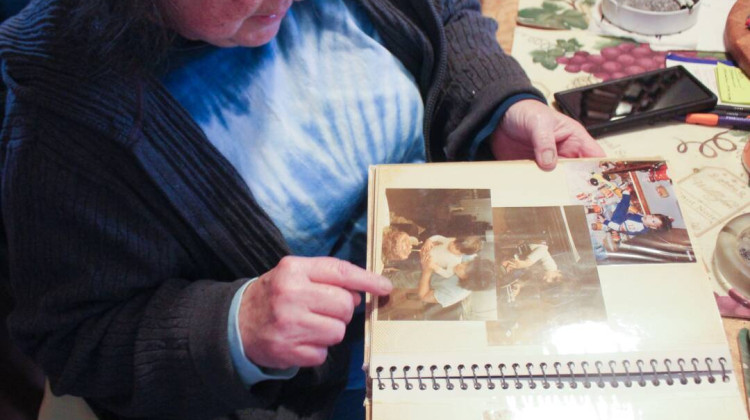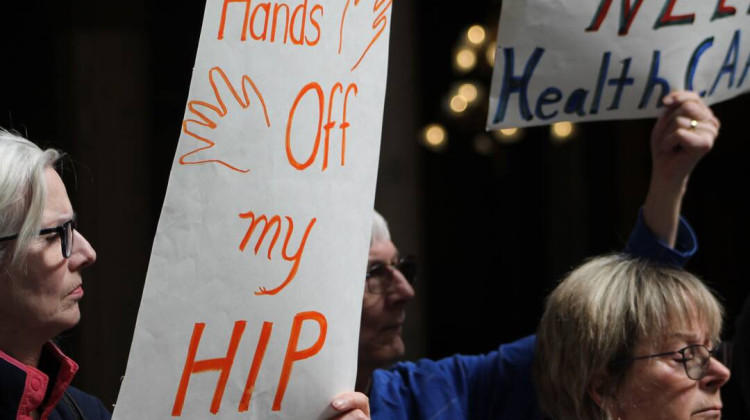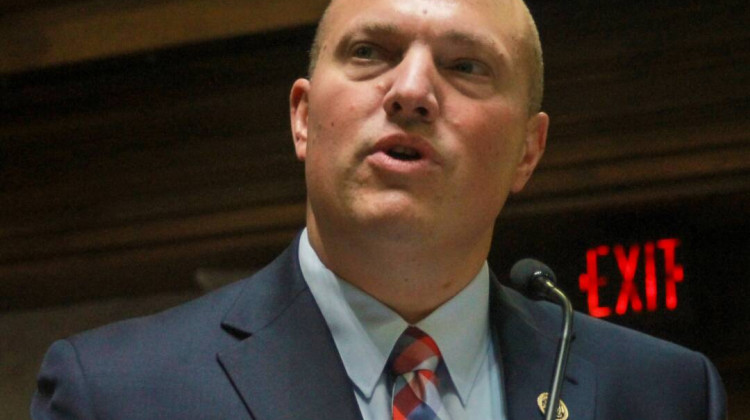RASMUS S. JORGENSEN - The Elkhart Truth
ELKHART, Ind. (AP) — The local Amish population faces barriers to getting vaccinated for COVID-19 that other groups do not, as Hoosiers generally need to make vaccination appointments online or by phone and clinics are located in towns and cities.
About 26,000 Amish residents live in Elkhart and LaGrange counties, according to the Young Center for Anabaptist and Pietist Studies at Elizabethtown College. In Elkhart County, a direct effort to get shots to the Amish has yet to launch, according to county Health Officer Dr. Bethany Wait.
First, she said, the county and state are reaching out with information.
“We are at the point where they are not ready to choose vaccines. I think we are at the point where they want more information about vaccines. At least that’s the feedback that we’re getting,” she said.
Wait believes the Elkhart County Health Department, not the state, should be in charge of getting doses to the Amish community when that time comes.
“We’re going to have to do that. I think we have the closest relationship, in general, with the Amish population,” she said.
But for now – even if members of the Amish community wish to get vaccinated it isn’t easy, according to Wait.
“I don’t think you can target the Amish population if you’re requiring online registration,” she said.
Sociologist Cory Anderson, a postdoctoral scholar at Penn State University and editor of the Journal of Amish and Plain Anabaptist Studies, said the Amish have ways of getting around the barriers, but the fact that barriers exist is likely to mean fewer get vaccinated.
“Even though the Amish and the conservative Mennonites are going to have restrictions of one nature or another on the internet and telephone access, they’ve lived with these restrictions so long that they know full-well what are workarounds to getting to what they need to get access to,” Anderson said. “If the desire is there among Amish individuals to seek out a vaccine, I don’t think registering for them through the telephone or even through the internet is going to be an issue for most Amish.”
Another issue is transportation. According to the Indiana State Department of Health, the vaccination sites nearest to the local Amish communities are in Goshen and Topeka. LaGrange County only has one other site, which is in Howe, and the nearest site in Kosciusko County is in Warsaw.
“While arranging long-distance transportation in a motor vehicle can be a little bit of a hassle for the Amish, they coordinate their transportation together; they’ve got ways to get places where they need to go. But it is going to be a little more hassle than for those of us that can just hop in a personally owned automobile and go where we need to,” Anderson said. “But I wouldn’t say that the obstacle is a great struggle or insurmountable.”
Still, it could be the barrier that keeps some from getting immunized, he said.
“The Amish are very busy people, so it’s going to be a little extra hassle, and that might be a little bit of a reason why they might not seek out the vaccine as readily,” he said.
Anderson praised Indiana health officials for their outreach to Amish communities during the pandemic.
“In my observations of the northern Indiana Amish community, and especially in Elkhart County, the health department has been fairly proactive throughout the entire coronavirus pandemic to communicate with the Amish and Mennonite population locally,” Anderson said.
One example of that is the state running advertisements in Amish newspapers, encouraging vaccination and providing the 211 phone number that can be used to book appointments.
In the past few months, Anderson has been researching what might explain Amish and Mennonite hesitance toward getting vaccinated for COVID-19. Those groups are generally more hesitant than the population at large, though some other groups tend to skeptical as well. One of the reasons for the hesitancy is a strong sense of identity as Amish and Mennonite people, Anderson said.
“That translates into a desire to be in control of and have ownership of their own affairs,” he said. “So they are going to be suspicious of a program that comes pushing into the setting without first gauging their opinion or getting their reactions or giving them time to own that particular program as theirs.”
The Amish have a strong collective memory of persecution in Europe. Even if today’s Amish population has not lived through the same persecution, that collective memory causes a stronger distrust of government and science than many others have, according to Anderson.
A final reason for Amish hesitancy is their strong opposition to abortion, Anderson said. Though the available COVID-19 vaccines do not contain aborted fetal cells, Pfizer and Moderna tested their vaccines using fetal cell lines that descend from cells taken from elective abortions in the 1970s and 1980s, and Johnson & Johnson use fetal cell lines in testing and now in production, according to infectious diseases expert Dr. James Lawler.
“Even that is enough to make them very nervous,” Anderson said. “The facts about that particular issue maybe muddy people’s understanding so they don’t even really know what’s true.”
And the issue isn’t just with COVID-19 vaccines. Anderson said a study completed before the coronavirus pandemic showed that acceptance of vaccines declined in one Amish community in Ohio in the last decade.
But there are no rules against vaccines, so those who want a shot and can get around the barriers can get vaccinated.
In LaGrange County, about one-third of the county’s roughly 40,000 residents are Amish, according to AmishAmerica.com. Because of the large Amish population, the state is working with Topeka Pharmacy, which owner Trevor Thain said has had some success getting shots to those communities, even though difficulties persist.
“I am starting to see more and more people come in and get their vaccines, including some Amish,” Thain said.
Many Amish are skeptical, he said, but that is also the case for other parts of the population. LaGrange County was the least successful in the state at getting residents older than 16 vaccinated until late March, but, with its 13.4 percent, it has overtaken Newton County, according to the Indiana State Department of Health.
Elkhart and Daviess counties, at 18.4 and 17.9 percent, respectively, are also lagging the state as a whole, which is now at 21.4 percent. It is worth noting, Anderson said, that counties with large Amish populations tend to have a large percentage of young residents, who haven’t been able to get vaccinated for as long older residents.
Thain hopes that, as elders and well-respected members of Amish communities are getting their second doses of the Moderna vaccine without significant side effects, others will be persuaded to get their shots as well. According to Anderson, Amish communities value internally produced knowledge highly, so those sorts of experiences could be effective.
Since doses stay good for only six hours after being removed from refrigeration, Topeka Pharmacy generally requires people to sign up by calling or visiting the pharmacy website. But some walk-ups have been allowed, especially for the Amish.
“As far as our Amish patients are concerned, we’ve tried to do a lot of on-the-spot education, and we try to make it work to get them in that day if they’re interested,” Thain said.
The pharmacy recently set up a one-day clinic at a local school in order to reach local school employees, and more clinics at large employers are coming up. Thain said the pharmacy is also working on other partnerships that would hopefully break down some of the barriers to getting the Amish vaccination, which could mean setting up clinics that would allow them to not travel as far.
Wait said it may be necessary to go out to the Amish communities and do walk-up appointments, most likely with the one-dose Johnson & Johnson vaccine. No such clinics are planned for Elkhart County, though a spokesperson for the Indiana State Department of Health said they sent a mobile unit to Daviess County, which also has a large Amish population. The spokesperson did not answer whether registration via phone or the internet is required, but it was when one of the state’s units came to Elkhart in late March.
In Elkhart County, many Amish residents have ties to Clinton Frame Mennonite Church, where the county Health Department provides childhood vaccinations. For that reason, the church – which could not be reached for comment – will likely be among the sites that the county will use for the coronavirus vaccination effort, Wait said. As for other locations, the county at least needs to be able to refrigerate vaccines, so some source of electricity is necessary.
Though there isn’t a specific plan yet, Wait said the county is committed to reaching everyone, including the Amish.
“Our goal is to vaccinate anybody who wants to be vaccinated,” she said.
Megan Wade-Taxter with the Indiana State Department of Health said the department is working with local health departments, federally qualified health centers, and their own mobile units to “ensure that vaccine is deployed to areas that have difficulty accessing it.” She did not provide further details.
 DONATE
DONATE







 Support WFYI. We can't do it without you.
Support WFYI. We can't do it without you.